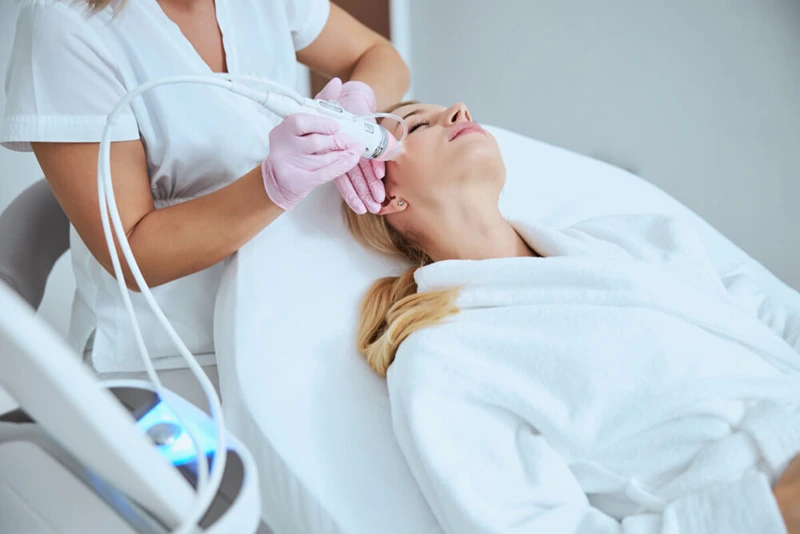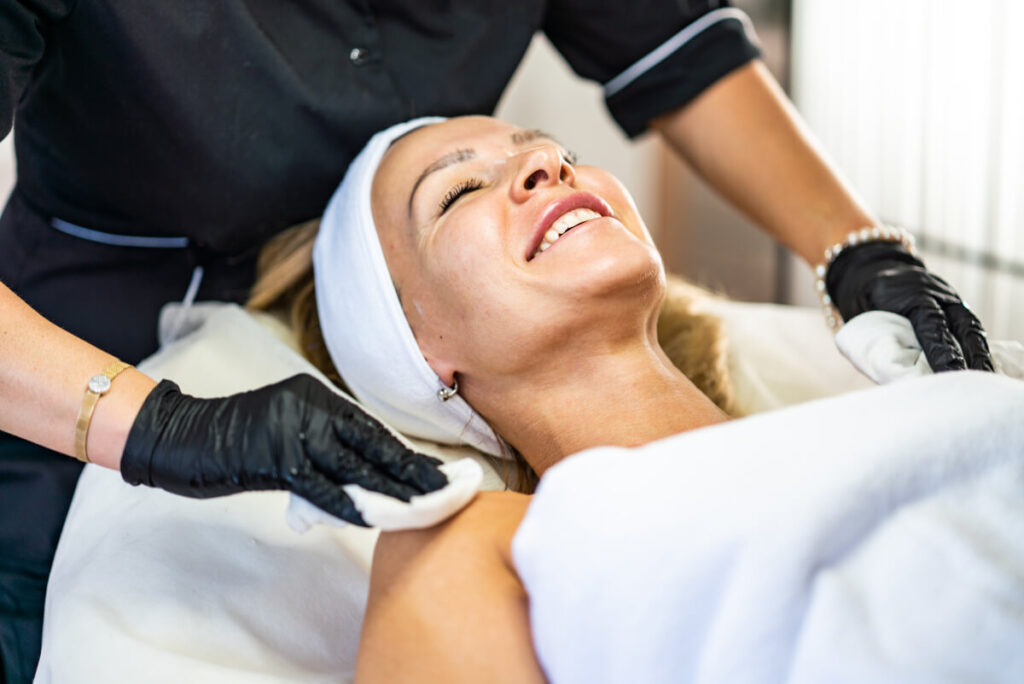What Happens To The Skin After CO2 Fractional Laser?

Perfect skin perhaps may be considered a dream of many. As such, many cosmetic procedures have been developed and popularized that may help achieve this dream. One of the forerunners of these cosmetic procedures is laser resurfacing treatments such as CO2 fractional laser which is an example of ablative treatments.
So what happens to the skin after a CO2 fractional laser? The CO2 laser causes the destruction of old collagen fiber and old epidermal skin cells to allow the boosted production of collagen and skin cells. Improving your skin condition is the main benefit of CO2 fractional laser, and common skin concerns like lesions and warts are removed.
Read More: Can You Get Fractional Radiofrequency Microneedling If You Have Fillers?
Rejuvenate and heal your face with the technique proven time and time again to provide maximum regenerative results: microneedling. Call us today to book your microneedling appointment at aNu Aesthetics.
The Science Behind CO2 Fractional Laser
Carbon dioxide (CO2) fractional laser skin resurfacing is a laser procedure wherein the carbon dioxide laser beam emits a maximum of 16,000 nm, a wavelength of light readily absorbed by the water content of the skin cells of the epidermis.
The absorption of the laser beam by water causes the vaporization of skin cells leading to their destruction, which in turn causes new skin cells to resurface in a process called re-epithelialization that occurs 6 to 7 days after treatment session.
The destruction of skin cells also stimulates collagen production. Through the destruction of old collagen fiber, the remodeling of collagen makeup in the dermis causes the retraction of collagen, which results in visible skin tightening.
Aside from vaporization, skin cells may also undergo fragmentation and ablation through CO2 laser since it produces heat in contrast to erbium laser, leading to the removal of the epidermal layer of skin. The heat from CO2 laser also causes less bleeding through causing the coagulation of blood in the small blood vessels. This in turn hastens re-epithelialization (the creation of a protective layer against the environment) in the dermis.
Different temporal beam modes also exist for the CO2 laser, which operates differently and emits laser beams on different scanning patterns. These modes include the continuous wave (CW) and quasi-CW, with the latter offering the advantage of maximum ablation with less thermal damage to the skin.
Benefits Of CO2 Fractional Laser And How They Are Achieved
CO2 fractional laser has found tons of uses for various skin concerns, which may be medical or cosmetic purposes. The indications for CO2 fractional laser include the following:
1) Skin Lesions
CO2 fractional laser can be used for benign skin growths such as nevus cells, seborrheic keratosis, syringomas, and xanthelasmas. Nevus cells may be flattened using CO2 fractional laser after local injection anesthesia, while seborrheic keratosis, syringomas, and xanthelasmas may be removed also using CO2 fractional laser after topical anesthesia.
Malignant skin lesions may also be treated using CO2 fractional laser as an alternative to open surgery, given that the malignancy has little risk for metastasis or distribution to other parts of the body other than in the original area it has developed.
2) Warts
Warts caused by the human papillomavirus (HPV) may also be healed using CO2 fractional laser under local anesthesia. It’s a good alternative to traditional approaches such as cryotherapy because patients may be more compliant to treatment due to less discoloration due to burning and less healing time incurred. However, patients should also be advised on the possible recurrence of warts if the virus will remain in the adjacent tissues and on possible permanent scarring.
3) Toenail Disease
Onychodystrophy or abnormalities in nail appearance may be treated by CO2 laser treatment by exposure of the nail to the laser beam. Ingrown toenails may also be treated by CO2 laser treatment through wedge resection.
CO2 laser treatment has a lesser risk of bleeding in contrast to the traditional method used in addressing these concerns in which surgical separation of the nail from the nail bed is done.
4) Skin Rejuvenation
Ablative treatments such as CO2 fractional laser treatment are regarded as gold standard treatments to achieve rejuvenated skin by addressing skin concerns such as wrinkles, fine lines, and acne scars. It’s the most obvious and most popular procedure resulting from the stimulated production of collagen due to the ablation of the epidermis and coagulation of its blood vessels.
Does The Result Of CO2 Fractional Laser Last?
The skin tightening effect of CO2 fractional laser is permanent; that is, the collagen remodeling that resulted as an effect of this treatment doesn’t go away once it has been done. However, what this treatment can’t stop is the skin’s natural aging process. Signs of aging such as age spots, wrinkles, and fine lines may again be visible after a while. As such, touch-ups are required to maintain the beautiful skin conferred by this treatment, which is recommended that you do every 3 to 5 years or until the results last.
Safety Of CO2 Fractional Laser Treatment
Despite the aggressiveness of the laser procedure, CO2 fractional laser treatment is a safe procedure. Precautions are followed by the laser resurfacing provider in ensuring the safety of laser patients, such as providing the patient with safety goggles to protect the eyes from the damage that may be caused by the light energy emitted by the device. Gauze is also draped around the target area, which is kept damp throughout the procedure to avoid starting fire.
Complications Of Laser Skin Resurfacing Procedure
Downtime after CO2 fractional laser lasts 7 to 10 days after treatment, with side effects such as minor swelling, redness, and scabbing visible within this period. Redness may even be present for months. These side effects may subside on their own, although cold compress and prescription pain medications may be used to lessen the discomfort caused by these symptoms.
Touching the laser-treated areas should be avoided in order not to put your skin at risk of infection. Bandages and dressings used after the procedure should also be removed 48 hours after surgery in order to also avoid fungal and bacterial infection. Irregular pigmentation may also be expected to occur due to CO2 fractional laser resurfacing.
Similarly, it should also be noted that CO2 laser skin resurfacing procedure isn’t for everyone, and must be avoided by people with certain medical conditions that may increase the risk of more significant complications of CO2 laser procedure. These include those with an increased disposition for the formation of hypertrophic scars and keloids, those who are undergoing chemotherapy and radiotherapy, and those with other skin diseases such as vitiligo and psoriasis.
A medical history of herpes should also be informed to your laser resurfacing provider so you may be given valacyclovir (an antiviral medication effective for herpes infection) before you proceed with the procedure. This preventive measure avoids the reactivation of herpes manifested as cold sores that may be triggered by the procedure.
Aftercare is suggested to be done in order to minimize complications and expedite the healing process. The first to be considered in taking care of the skin is that the skin is extra sensitive after the treatment. With that, heavy sun exposure must be avoided to prevent further damage to the skin to occur or, if unavoidable, make it a point to always use a “broad-spectrum” sunscreen. Applying harsh products must also be avoided and gentle cleansing may be initiated by using a diluted vinegar solution. Strenuous physical activity must be avoided as well.
Learn More: Pros And Cons Of Fractional Laser Skin Treatments
Professional Cosmetic Services At aNu Aesthetics

Through the processes initiated by CO2 fractional laser to the skin, the epidermis, the outer layer of skin, is shed, causing new cells of this layer to proliferate. Collagen remodeling also results from these processes. The said mechanisms are the reasons for both the benefits and potential risks of the laser treatment, although safety is always ensured throughout the procedure.
Patient satisfaction and comfort are our priority at aNu Aesthetics. We assure you that your skin is well taken care of throughout the procedure by our team of qualified laser resurfacing providers and staff headed by Dr. Cristyn Watkins. Achieve the youthful skin you desire and deserve and contact us now at (816) 670-4406.
Rejuvenate and heal your face with the technique proven time and time again to provide maximum regenerative results: microneedling. Call us today to book your microneedling appointment at aNu Aesthetics.